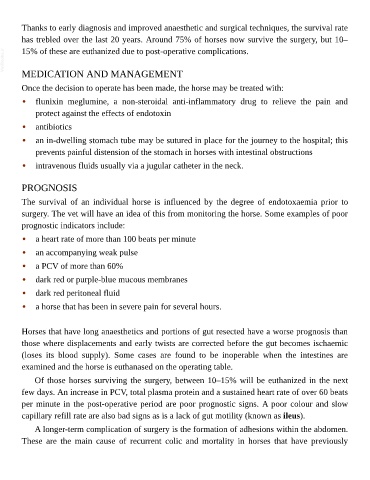Page 775 - The Veterinary Care of the Horse
P. 775
Thanks to early diagnosis and improved anaesthetic and surgical techniques, the survival rate
has trebled over the last 20 years. Around 75% of horses now survive the surgery, but 10–
VetBooks.ir 15% of these are euthanized due to post-operative complications.
MEDICATION AND MANAGEMENT
Once the decision to operate has been made, the horse may be treated with:
• flunixin meglumine, a non-steroidal anti-inflammatory drug to relieve the pain and
protect against the effects of endotoxin
• antibiotics
• an in-dwelling stomach tube may be sutured in place for the journey to the hospital; this
prevents painful distension of the stomach in horses with intestinal obstructions
• intravenous fluids usually via a jugular catheter in the neck.
PROGNOSIS
The survival of an individual horse is influenced by the degree of endotoxaemia prior to
surgery. The vet will have an idea of this from monitoring the horse. Some examples of poor
prognostic indicators include:
• a heart rate of more than 100 beats per minute
• an accompanying weak pulse
• a PCV of more than 60%
• dark red or purple-blue mucous membranes
• dark red peritoneal fluid
• a horse that has been in severe pain for several hours.
Horses that have long anaesthetics and portions of gut resected have a worse prognosis than
those where displacements and early twists are corrected before the gut becomes ischaemic
(loses its blood supply). Some cases are found to be inoperable when the intestines are
examined and the horse is euthanased on the operating table.
Of those horses surviving the surgery, between 10–15% will be euthanized in the next
few days. An increase in PCV, total plasma protein and a sustained heart rate of over 60 beats
per minute in the post-operative period are poor prognostic signs. A poor colour and slow
capillary refill rate are also bad signs as is a lack of gut motility (known as ileus).
A longer-term complication of surgery is the formation of adhesions within the abdomen.
These are the main cause of recurrent colic and mortality in horses that have previously

